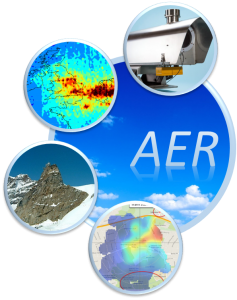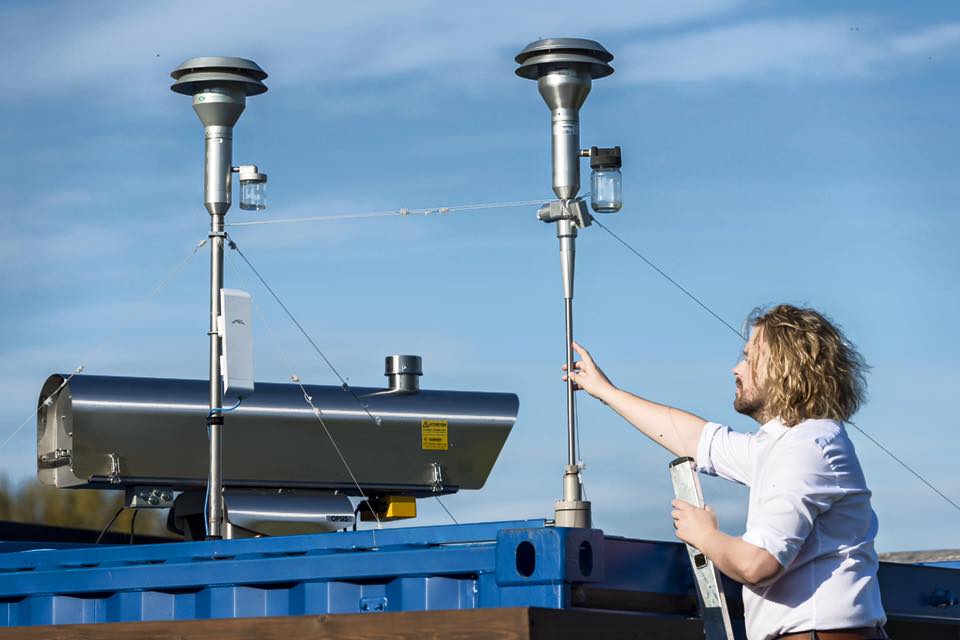Dr Kevin Wyche is an Honorary Research Fellow within the school of Environment and Technology, and founding member of the University of Brighton Air Environment Research (AER) team – a key element of the school’s Environment and Public Health research group. Kevin is also an Honorary Senior Lecturer in the Department of Chemistry at the University of Leicester and Project Manager for the University of Brighton’s Economic And Social Engagement (EASE) group.
Kevin joined the University of Brighton in 2011, having previously worked as a Senior Post Doctoral Research Associate in the Atmospheric Chemistry Group at the University of Leicester; his research interests include tropospheric composition and change, Secondary Organic Aerosol (SOA) formation and evolution, air quality science and analytical instrumentation and instrument development (e.g. Differential Optical Absorption Spectroscopy and Chemical Ionisation Reaction Mass Spectrometry).
Dr Wyche has extensive field work experience, having worked on over 15 different field campaigns, which have seen his deployment to sites from the Svalbard archipelago in the high arctic to the summit of the Jungfraujoch in the free troposphere of the Alps. Amongst others, over the last decade he has work on four large NERC consortium projects and several major European ventures, including the €7M Joint Air Quality Initiative (JOAQUIN), part funded by INTERREG IVB. He has authored/co-authored 24 scientific journal articles and book chapters to date and has contributed towards the acquisition of successful grants worth in excess of £XXXX. Kevin has supervised and mentored many undergraduate and postgraduate students, including 2 PhD students.
Kevin is currently scientific lead for the AER team’s Joaquin Advanced Air Quality research Station (JAAQS), he lectures in Air Quality Management and project manages a portfolio of the University of Brighton’s research ventures.
How I Like to Teach
I really enjoy all aspects of teaching, from scheduled lecturing to project supervision. My teaching is always underpinned by my practical experience in the research sector and I like to bring all of my positive experiences designing hardware, collecting and interpreting data and publishing findings in a competitive field, into my classes. I always like to encourage two-way dialogue in all of my lectures and try to make sure all of my students feel fully involved during my classes. Where possible I like to include practical elements into my teaching framework and I always try to ensure that these have tangible links to up-to-date, cutting edge research; whether this be analysing data collected minutes before using the latest sophisticated software techniques, or interpreting phenomena in the environment around us using space-borne instruments. I am always keen to engage with and employ the latest teaching aids, and use tools such as NearPod and vlogs to help create the best possible learning experience for my students. To support my scheduled teaching activities, I like to have a relaxed, “open door” policy and encourage students to call by with any questions they have or if they feel they need a little extra help.
Research Interests
My research interests focus on the study of the Earth’s atmosphere, with particular emphasis on tropospheric chemistry and air pollution. My three principle areas of research are:
Fundamental chemical processes controlling tropospheric composition & change
The Earth’s atmosphere is a hugely complex, multi-phase system, the chemistry of which is controlled by tiny quantities of reactive species, including oxides of nitrogen, ozone, and volatile organic compounds. These trace species, and their tropospheric chemistry lie at the heart of many of our contemporary environmental and air quality issues, including summertime smog and particle formation. In order to better understand the roles and impacts of such reactive species within the Earth’s atmosphere, we have been using environment chambers and chemical modelling to simulate and study their reaction mechanisms. The primary focus of my own research in this area is the atmospheric oxidation of volatile organic compounds and their partitioning to the particle phase to form Secondary Organic Aerosol (SOA).
Air quality science
Air pollution is a hugely important issue for society today, with poor air quality being responsible for an estimated xxx premature deaths in Europe alone (YEAR), and for imposing a burden of around XX€ on the European economy. Many of the scientific questions I investigate as part of my research into fundamental tropospheric processes, lie at the heart of contemporary air pollution problems and as such synergise with my work observing the “real” atmosphere. Using the state-of-the-art Advanced Air Quality research Station (JAAQS) at the University of Brighton, I am able to probe the air we breathe in great detail and study a plethora of reactive trace species and air pollutants, including so called “ultrafine particles” (UFP), for which there is emerging evidence regarding their significantly hazardous nature to human health.
Analytical instrument development and deployment
In order to study the gases and particles that make up the atmosphere, we must first be able to develop and deploy state-of-the-art analytical instrumentation to observe them with a high degree of accuracy and precision. My research into analytical instrumentation is centred on the development of instruments to monitor trace gases, in particular volatile organic compounds, latterly using Chemical Ionisation Reaction Mass Spectrometry (CIR-MS) and now using Differential Optical Absorption Spectroscopy (DOAS). In particular, my current research involves using DOAS to monitor formaldehyde and nitrous acid in order to investigate their roles in urban atmosphere processes. My recent research with analytic instrumentation also involves the application of commercialised particle counting technology to study UFP’s in urban air.
Research Projects
Fundamental chemical processes controlling tropospheric composition and change
• Mass Spectrometry for the CHemical Analysis of Secondary organic aerosol (MSCHAOS) – ACCENT/EPSRC
• Aerosol Coupling in the Earth’s System (ACES) – NERC
• Total RAdical production and degradation Products from alkene OZonolysis (TRAPOZ) – NERC
• TOluene OXidation In a Chamber (TOXIC) – EUROCHAMP
• Are glyoxal and methyl glyoxal critical to the formation of a missing fraction of SOA? (PHO-SOA) – NERC
• Aerosol-Cloud Interactions-a Directed Program to Reduce Uncertainty in Forcing through a targeted laboratory and modelling program (ACID-PRUF) – NERC
Air quality science
• Leicester Air Monitoring Project (LAMP) – University of Leicester/EPSRC
• JOint Air QUality INitiative (JOAQUIN) – University of Brighton/INTERREG IVB
• JOAQUIN Advanced Air Quality research Station (JAAQS) – University of Brighton
Analytical instrument development and deployment
• Development characterisation and implementation of Chemical Ionisation Reaction Mass Spectrometry – EPSRC
• ACCENT OVOC intercomparison – ACCENT/EPSRC
Other Projects
• Space Plasma Exploration by Active Radar (SPEAR; construction) – PPARC/NERC
Contact me
Dr Kevin P. Wyche
Environment and Technology
Moulsecoomb
Brighton
BN2 4GJ
Telephone: +44 (0)1273 642915
Email: k.p.wyche@brighton.ac.uk
Biography
I have always been interested in how things work in the world around us and have always been fascinated by the Earth and its place in our solar system. This led me to embark on a BSc. degree in Physics with Space Science and Technology at the University of Leicester, from which I graduated in 2003. During my time in the Department of Physics and Astronomy at Leicester, I developed a keen interest in instrumentation and its application to monitor the Earth system – particularly the atmosphere – both from the ground and space. After my graduation I was fortunate enough to obtain a place on the field team being deployed to the Svalbard archipelago to construct the SPEAR radar array, a system that would later be used to probe the Earth’s upper atmosphere; this amazing experience fuelled my interest in the study of the atmosphere and led into my studying for an MSc. in Atmospheric Science at the University of East Anglia, from which I graduate with Distinction in 2004.
Straight after my MSc. I had the privilege to be accepted as a Ph.D student for Professors Paul Monks and Andy Ellis in the Atmospheric Chemistry group, back at the University of Leicester, working on the development of instrumentation to monitor reactive trace species in the troposphere. Working for Paul and Andy was amazing, it gave me the opportunity to work with a fantastic group of people at the cutting edge of an important and fascinating scientific field; it gave me the opportunity to work in a range of places, from government laboratories to the top of the Alps and allowed me to develop a range of invaluable, multi-disciplinary skills. I graduate from my Ph.D in 2009 and was privileged to receive the University of Leicester Faculty of Science and Engineering PH.D Medal, for the work I conducted during my Ph.D.
Between 2007 and 2011 I continued to work for Paul in the Atmospheric Chemistry group as a Post-Doctoral Researcher, with a short break during which I worked as an Earth Observations Specialist for the group’s innovation hub, G-STEP. During this time I worked on 5 major consortium projects, investigating fundamental chemical processes in the troposphere, including the oxidation of atmospherically important volatile organic compounds and secondary organic aerosol formation. These projects allowed me to conduct extensive work at both the Manchester Aerosol Chamber and the European Photo-reactor, in Spain.
During my time at Leicester, I was also involved in the writing of a large consortium grant application to investigate air pollution in North West Europe; this proposal was accepted by the EU INTERREG programme in 2011 and soon after the Joint Air Quality Initiative (JOAQUIN) was launched. JOAQUIN gave me the opportunity to move to the University of Brighton, where I established the Air Environment Research team, along with my colleague, Dr Kirsty Smallbone. During my work Project Managing the JOAQUIN project, I set up the university’s new Advanced Air Quality research Station (JAAQS), which was inaugurated by Caroline Lucas MP in December 2015. JAAQS comprises one of the UK’s most highly instrumented, permanent air monitoring observatories currently in operation and is one of my proudest achievements.
Selected Publications
(1) Cordell, … Wyche et al., 2016, Evaluation of Biomass Burning across North-West Europe and Its Impact on Air Quality. Submitted to Atmos. Env., at review
(2) Hofman,… Wyche et al., 2016, Ultrafine particles in four European urban environments: first results of a continuous long-term monitoring network. Submitted to Atmos. Env., at review
(3) Periera,…Wyche et al., 2015, Insights into the Formation and Evolution of Individual Compounds in the Particulate Phase during Aromatic Photo-Oxidation. Env. Sci. Tech. 49, 13168-13178
(4) Wyche et al., 2015, Mapping gas-phase organic reactivity and concomitant secondary organic aerosol formation: chemometric dimension reduction techniques for the deconvolution of complex atmospheric datasets. Atmos. Chem. Phys. 15, 8077-8100
(5) Wyche et al., 2014, Emissions of biogenic VOCs and subsequent photochemical production of secondary organic aerosol in mesocosm studies of temperate and tropical plant species. Atmos. Chem. Phys., 14, 12781-12801
(6) Alam,… Wyche et al., 2013, Radical product yields from the Ozonolysis of Short Chain Alkenes under Atmospheric Boundary Layer Conditions. Journal Phy. Chem. A, 117, 12468-12483
(7) Alfarra,.. Wyche et al., 2013, Water uptake and composition of biogenic secondary aerosols. Atmos. Chem. Phys., 13, 11769-11789
(8) Bloss,… Wyche et al., 2012, Production of the atmospheric oxidant radicals OH and HO2 from the ozonolysis of alkenes IN Disposal of Dangerous Chemicals in Urban Areas and Mega Cities, NATO Science for Peace and Security Series C: Environmental Security, 151-162
(9) Alfarra,.. Wyche et al., 2012, The effect of photochemical ageing and initial precursor concentration on the composition and hygroscopic properties of b-caryophyllene secondary organic aerosol. Atmos. Chem. Phys., 12, 6417-6436
(10) Jenkin, Wyche et al., 2012, Development and chamber evaluation of the MCM v3.2 degradation scheme for β-caryophyllene. Atmos. Chem. Phy., 12, 5275-5308
(11) Hamilton,.. Wyche et al., 2011, Investigating the use of secondary organic aerosol as seed particles in simulation chamber experiments. Atmos. Chem. Phys., 11, 5917-5929
(12) Alam,.. Wyche et al., 2011, Total radical yields from tropospheric ethene ozonolysis. Phys. Chem. Chem. Phys., 13, 11002-11015
(13) Rickard, Wyche et al., 2010, Gas phase precursors to anthropogenic secondary organic aerosol: Using the Master Chemical Mechanism to probe detailed observations of 1,3,5-trimethylbenzene photo-oxidation. Atmos. Env., 44, 5423-5433
(14) Wyche et al., 2010, How clean is our air? Local air quality monitoring and a role for GMES. 25 Uses of GMES in the NEREUS Region, 37-38
(15) Camredon,.. Wyche et al., 2010, Gas phase precursors to anthropogenic secondary organic aerosol: detailed observations of 1,3,5-trimethylbenzene photooxidation. Atmos. Chem. Phys., 10, 2893-2917
(16) Parker,.. Wyche et al., 2008, Peroxy radicals in the summer free troposphere: seasonality and potential for heterogeneous loss. Atmos. Chem. Phys., 9, 1989-2006
(17) Wyche et al., 2008, Gas phase precursors to anthropogenic secondary organic aerosol: detailed observations of 1,3,5-trimethylbenzene photooxidation. Atmos. Chem. Phys., 9, 635-665
(18) Apel…Wyche et al., 2008, Intercomparison of oxygenated volatile organic compound (OVOC) measurements at the SAPHIR atmosphere simulation chamber. J. Geophys. Res., 113 (D20), D20307
(19) Wyche et al., 2008, Chapter 5, Atmospheric monitoring with chemical ionisation reaction time-of-flight mass spectrometry (CIR-TOF-MS) and future developments: Hadamard transform mass spectrometry, 64 – 76, IN Young & Platt (2008) Advanced Environmental Monitoring, Springer-Verlag. ISBN: 978-1-4020-6363-3
(20) Cordell, Wyche et al., 2007, Detection of Chemical Weapon Agents and Simulants Using Chemical Ionization Reaction Time-of-Flight Mass Spectrometry. Anal. Chem., 79(21), 8359-8366
(21) Whyte, Wyche et al., 2007, Fast fingerprinting of arson accelerants by proton transfer reaction time-of-flight mass spectrometry. Int. J. Mass Spectrom., 263 (2-3), 222-232
(22) Wyche et al., 2007, Technical Note: Performance of Chemical Ionization Reaction Time-of-Flight Mass Spectrometry (CIR-TOF-MS) for the measurement of atmospherically significant oxygenated volatile organic compounds. Atmos. Chem. Phys., 7, 609-620
(23) Blake, Wyche et al., 2006, Chemical ionization reaction time-of-flight mass spectrometry: Multi-reagent analysis for determination of trace gas composition. Int. J. f Mass Spectrom., 254 (1-2), 85-93
(24) Wyche et al., 2005, Differentiation of isobaric compounds using chemical ionization reaction mass spectrometry. Rapid Commun. Mass Spectrom., 19 (22), 3356-3362
Project Management Portfolio
• JOAQUIN (SET)
• INSPIRE (BBS)
• ACROBAT (PABS)
• SEMESA (ERC)
Links
• EPHRG – https://www.brighton.ac.uk/research/our-research/life-health-and-physical-sciences/research-groups/environment-and-public-health/index.aspx
• University of Leicester Atmospheric Chemistry – http://www2.le.ac.uk/departments/chemistry/research/atmospheric-chemistry-1
• Joint Air Quality Initiative – http://www.joaquin.eu/



